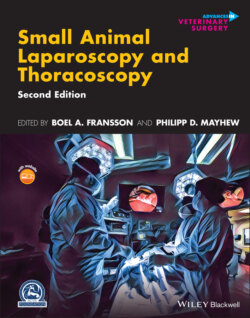Читать книгу Small Animal Laparoscopy and Thoracoscopy - Группа авторов - Страница 94
Forceps
ОглавлениеLaparoscopic forceps can be divided into three categories: grasping forceps, dissecting forceps, and biopsy forceps. Just as in open surgery, the type of forceps selected will depend on its intended use. The jaws of laparoscopic forceps can be crushing or noncrushing, straight or curved, and long or short. Some forceps are designed as either graspers or dissectors; others may be used simultaneously for both functions. In addition, graspers can be used as tissue retractors.
Grasping forceps are used to grasp tissue for stabilization, relocation, or hemostasis. Noncrushing forceps most commonly used in small animal laparoscopy and thoracoscopy are Babcock and Duval forceps (Figure 4.4). The jaws of endoscopic Babcock forceps are identical to their open surgical counterparts. They are most commonly used to grasp and manipulate the pyloric antrum during laparoscopic‐assisted gastropexy. Duval forceps are similar to Babcock forceps except that the jaws are slightly longer and offer a more aggressive grasp. For both Babcock and Duval forceps, a double‐action mechanism allows for a wider grasp to include more tissue and better prevent slipping.
Figure 4.4 Duvall and Babcock forceps (from left to right): 10‐mm, double‐action Duvall forceps; 10‐mm, double‐action Babcock forceps; and 5‐mm single‐action Babcock forceps.
Source: © 2014 Photo courtesy of KARL STORZ SE & CO, KG.
Many other types of grasping instruments are provided by the different manufacturers (Figure 4.5a). Basic designs include toothed graspers (varying number of teeth at the end of the instrument jaw), fenestrated graspers (a fenestrated slit is present down the length of the jaw), DeBakey graspers, Allis graspers, alligator graspers (pronounced transverse serrations for a stronger tissue grip), bowel graspers (longitudinal serrations, similar to a DeBakey), straight and curved atraumatic graspers (for grasping and removing hollow organs), and bullet‐nosed graspers (blunt‐nosed, atraumatic jaws for grasping delicate tissues). Although technically described as dissecting forceps, Kelly forceps can also be used to carefully grasp and move tissues such as the proper ligament during laparoscopic ovariectomy. Grasping forceps are usually placed on locking handles to facilitate a more secure grip of tissues during surgery.
The most commonly used dissecting forceps include Kelly dissectors and Maryland dissectors (which resemble Crile hemostatic forceps) (Figure 4.5b). They are available with straight or curved jaws, but most surgeons find that curved instruments improve tissue visualization during dissection. Needle‐nosed, tapered, bullet‐nose, and micro‐dissectors are also available. For dissection around ducts and vessels, right‐angled dissectors (see Figure 4.5b) and Mixter spreader dissectors are very useful. The Mixter dissector has a longer jaw and more acute angle at the tip than does the right‐angle dissector. Dissecting forceps may be on either ratcheted or nonratcheted handles. Using ratcheted handles allows some versatility when using the same instrument for both grasping and dissecting, as the locking mechanism allows for a more stable grasp. On the other hand, nonratcheted handles allow for a smoother motion when placing and spreading the instrument jaws during dissection and avoid accidental ratcheting of the handles. When dissecting around vessels, ducts, and other fragile tissue, it is best, however, to use a nonratcheted handle.
Biopsy forceps are available as cup biopsy forceps and as punch biopsy forceps (Figure 4.6). Punch biopsy forceps will cut tissue as one jaw “punches” through the fenestration in the opposite jaw. On the other hand, cup biopsy forceps provide some hemostasis by crushing and tearing tissues at the edges of the biopsy sample as the cup is closed and then gently twisted to obtain the specimen. Some cup biopsy instruments have a fine spike in one or both jaws to better secure tissue; however, this spike is not necessary to obtain adequate tissue samples for histologic analysis. In our practice, cup biopsy forceps are the most commonly used biopsy instrument for obtaining liver, splenic, pancreatic, adrenal, lymph node, and other soft tissue mass biopsies. Because punch biopsy forceps cut rather than tear, they may be more appropriate for use in tissues such as the pancreas, where tearing may incite inflammation and pancreatitis. Biopsy forceps can also be on either a ratcheted or nonratcheted handle; however, ratcheted handles allow for a better, more consistent grip on tissues while obtaining a biopsy sample.
Figure 4.5 (A). Grasping forceps (from top to bottom): straight dissecting and grasping forceps, curved dissecting, and grasping forceps, DeBakey grasping forceps, bowel grasper with longitudinal fenestration, bowel forceps, robust Reddick‐Olsen forceps, regular Reddick‐Olsen forceps, alligator jaw forceps, and toothed grasping forceps (“Tiger Jaws”). (B). Dissecting forceps (from top to bottom): 10‐mm, long Kelly forceps (not shown to scale); 5‐mm, long Kelly forceps; Kelly forceps; Noshiro forceps (for fine dissection); and right‐angled forceps.
Source: © 2014 Photos courtesy of KARL STORZ SE & CO, KG.
Figure 4.6 Biopsy forceps (from top to bottom): biopsy forceps without teeth, biopsy forceps with two teeth, and biopsy punch.
Source: © 2014 Photo courtesy of KARL STORZ SE & CO, KG.
